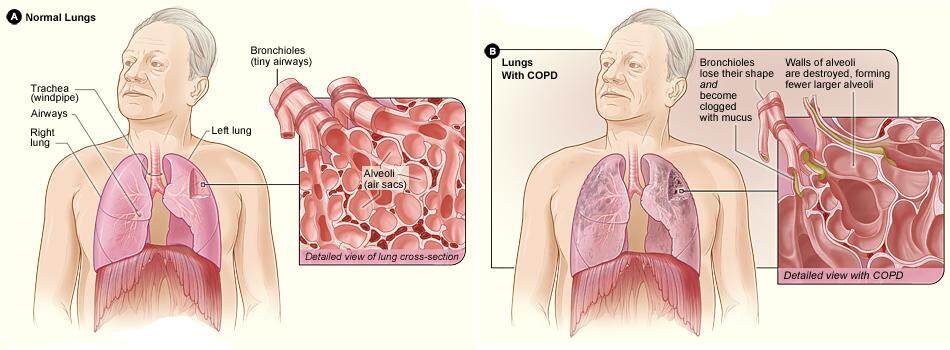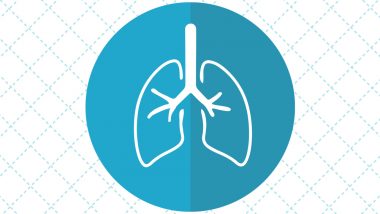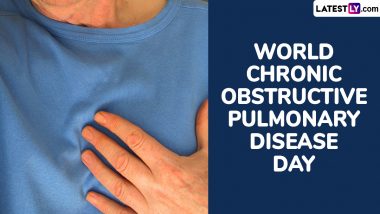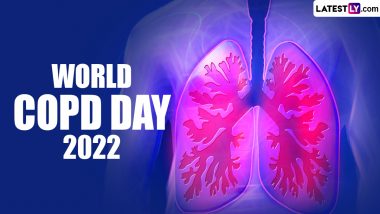COPD stands for Chronic Obstructive Pulmonary Disease, a list of diseases that affects the lungs. These diseases are considered irreversible or “poorly reversible” due to their progressive nature. India ranks among the highest in the world when it comes to COPD incidences, and it will only get worse. By 2020, these pulmonary diseases are touted to be the third-leading cause of death globally. The damage done by COPD is permanent, making breathing, a vital function, difficult. Day-to-day tasks like walking, carrying load, climbing the stairs, etc. tough to carry out. But bear in mind that it’s a preventable disease, which can be avoided by letting go of bad habits like smoking. On November 21 worldwide, World COPD Day is observed to spread awareness about the debilitating disease and to prevent people from falling prey to it. Here’s what we need to know about the symptoms, causes, risks and treatment of COPD.
What is COPD?
COPD or Chronic Obstructive Pulmonary Disease is a progressive lung disease that does permanent damage to the lungs. It narrows down the airways, making breathing difficult. World Pneumonia Day 2018: Causes, Symptoms and Treatment of This Deadly-But-Preventable Lung Disease.
However, COPD does not strike suddenly. It is a result of many years of damage, caused by a variety of factors, some of which can be preventable.
What Causes COPD?
COPD occurs due to inflammation in the bronchi, the air passage of the lungs. The air sacs inside the lungs may also get over-inflated, causing a condition called pulmonary emphysema.

The inflammation may be caused by frequent exposure to smoke, dust or gases, which damage the insides of the bronchi or the fine hair-like structure called cilia. The damaged cilia is unable to remove any kind of mucus build-up in the lungs, clogging the airways and causing breathing difficulties.
But of the primary factors that cause inflammation and damage to the lungs include:
-
- Smoking
- Second-hand smoking
- Exposure to smoke and pollutants
- Genetic factors
What Are The Symptoms of COPD?
Symptoms of COPD are all related to the respiratory system:
- Frequent coughing
- Wheezing
- Breathlessness
- Trouble breathing deeply
Who’s At Risk of COPD?
Studies note a strong connection between smokers and COPD, though not all smokers develop the disease. The ones who are at risk are smokers or former smokers. US Woman Kept Alive on The ‘Iron Lung’ Since 1956 After Her Lungs Stop Functioning Due To Polio.
Regular exposure to smoke, either at the workplace or homes, are the other causes. In India, women in the rural areas are more at risk of COPD due to extensive use of the chulha or rudimentary stove, which emits a lot of smoke. Diphtheria On The Rise In India: What Are The Causes, Symptoms and Treatment of This Infectious Disease?
Genetic factors also put one at risk of the disease. Congenital disabilities of the lungs in the womb and “alpha-1 antitrypsin deficiency also increase the risk.
Treating COPD
COPD often goes undetected at first, since many smokers believe it’s just a case of “smoker’s cough.” Tests done by lung specialists include physical examination, blood tests, lung functions, etc. will help rule out other diseases like asthma, heart failure or cancer. The tests can also determine the extent of the diseases.
Since COPD is a progressive disease, treatment mainly revolves around slowing down the speed of symptoms and improving the quality of life for the patients.
Medication includes a mix of bronchodilators, which widen the air passage to facilitate breathing. Corticosteroids are given to reduce the inflammation. Depending upon the stage of COPD, oxygen therapy is also given. A drug used in stem cell therapy to treat certain cancers may also protect against lung injury caused by cigarette smoke.
Physical exercises, breathing exercises and diet are used as supportive treatment measures.
Prevention of COPD
Since it’s an easily preventable set of diseases, COPD can be curbed even before it begins. First and foremost, quit smoking and look for nicotine replacement therapies.
Using protective measures such as gas masks to reduce the intake of polluted air and smoke into the lungs can help if you work or live in a polluted environment.
Flare-ups of COPD are also caused by respiratory disorders, and their symptoms can worsen the diseases even further. That’s why, people with COPD should avoid flu and cold as much as possible.
(The above story first appeared on LatestLY on Nov 21, 2018 12:23 PM IST. For more news and updates on politics, world, sports, entertainment and lifestyle, log on to our website latestly.com).













 Quickly
Quickly














 MI
MI







